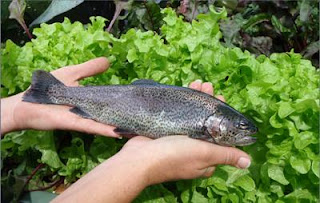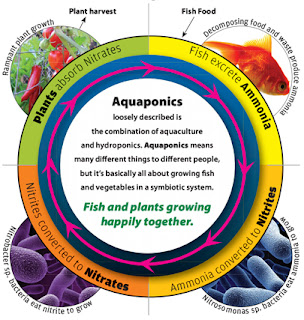Origins of Aquaponics
- by http://home.howstuffworks.com
Aquaponics, with its fancy name, may sound like a trendy new concept developed by environmentalists. But it's actually as old as the hills.
The origins of aquaponics can be traced to ancient Egyptian and Aztec cultures.
The ancient Aztecs developed chinampas, man-made floating islands, which consisted of rectangular areas of fertile land on lake beds.
Aztecs cultivated maize, squash and other plants on the chinampas and fish in the canals surrounding them.
The fish waste settled on the bottom of the canals, and the Aztecs collected the waste to use as fertilizer.
Additionally, countries in the Far East like Thailand and China have long used aquaponic techniques in rice paddies.
Background and Concept
Aquaponics is the symbiotic cultivation of plants and aquatic animals in a recirculating environment.
Aquatic animal effluent accumulates in water as a by-product of keeping them in a closed system or tank (such as in an aquaculture system). The effluent-rich water becomes high in plant nutrients but this is correspondingly toxic to the aquatic animal.
Plants are grown in a way (for example a hydroponic system) that enables them to utilize the nutrient-rich water. The plants take up the nutrients, reducing or eliminating the water's toxicity for the aquatic animal.
The water, now clean, is returned to the aquatic animal environment and the cycle continues. Aquaponic systems do not discharge or exchange water. The systems rely on the relationship between the aquatic animals and the plants to maintain the environment. Water is only added to replace water loss from absorption by the plants, evaporation into the air, or the removal of biomass from the system.
Aquaponic systems vary in size from small indoor units to large commercial units. They can use fresh or salt water depending on the type of aquatic animal and vegetation.
The Fish Tank
Aquaculture is the farming of freshwater and saltwater organisms such as finfish, mollusks, crustaceans and aquatic plants. Also known as aquafarming, aquaculture involves cultivating aquatic populations under controlled conditions, and can be contrasted with commercial fishing, which is the harvesting of wild fish.Commercial aquaculture supplies one half of the fish and shellfish that is directly consumed by humans.
In 2004, the total world production of fisheries was 140.5 million tonnes of which aquaculture contributed 45.5 million tonnes or about 32% of the total world production. The growth rate of worldwide aquaculture has been sustained and rapid, averaging about 8 percent per annum for over thirty years, while the take from wild fisheries has been essentially flat for the last decade.
The Vege Plot
Hydroponics is a method of growing plants using mineral nutrient solutions, in water, without soil. Terrestrial plants may be grown with their roots in the mineral nutrient solution only or in an inert medium, such as perlite, gravel, or mineral wool.
Researchers discovered in the 19th century that plants absorb essential mineral nutrients as inorganic ions in water. In natural conditions, soil acts as a mineral nutrient reservoir but the soil itself is not essential to plant growth. When the mineral nutrients in the soil dissolve in water, plant roots are able to absorb them. When the required mineral nutrients are introduced into a plant's water supply artificially, soil is no longer required for the plant to thrive.
Almost any terrestrial plant will grow with hydroponics. Hydroponics is also a standard technique in biology research and teaching.
Integration
Aquaponics is based on productive systems as they are found in nature. It can be loosely described as the combination of aquaculture and hydroponics and this is where the name aqua-ponics originates.
Hydroponic systems rely heavily on the careful application of man-made nutrients for the optimum growth of plants. The nutrients are made from mixing together a concoction of chemicals, salts and trace elements to form the ‘perfect’ balance. Water in hydroponic systems needs to be discharged on periodically, as the salts and chemicals build up in the water which becomes toxic to the plants. Aquaculture systems focus on maximising growth of fish in tank or pond culture.
The fish are usually heavily stocked in the tanks often, 10kg in 100L of water. The high stocking rates often mean that the tank water becomes polluted with fish effluent which gives off high concentrations of Ammonia. Water has to be discharged at a rate of 10-20% of the total volume in the tank once a day, everyday. This water is often pumped into open streams where it pollutes and destroys waterways.
Aquaponics combines both systems, and in doing so cancels out the negative aspects of each. Instead of adding toxic chemical solutions to grow plants, aquaponics uses highly nutritious fish effluent that contains almost all the required nutrients for optimum growth. Instead of discharging water, aquaponics uses the plants and the media in which they grow to clean and purify the water, after which it is returned to the fish tank. This water can be reused indefinitely and will only need to be replaced when it is lost through transpiration and evaporation.
There are three basic styles of aquaponic systems, which we discuss below in a little more detail.
DWC or Deep Water Culture
Deep Water Culture, works on the idea of floating plants on top of the water allowing the roots to hang down into the water. This can be done in a number of ways. This method is one of the more commonly practiced commercial methods. DWC can be done by floating a foam raft on top of the fish tank, however a more common method is to grow the fish in a fish tank and pump the water through a filtration system, and then into long channels where floating rafts filled with plants float on the water surface and extract the nutrients.
NFT or Nutrient Film Technique
Nutrient Film Technique is a commonly used hydroponic method, but is not as common in aquaponic systems. In NFT systems, nutrient rich water is pumped down small enclosed gutters, the water flowing down the gutter is only a very thin film. Plants sit in small plastic cups allowing their roots to access the water and absorb the nutrients. NFT is only really suitable for certain types of plants, generally leafy green vegetables, larger plants will have root systems that are too big and invasive, or they become too heavy for the lightweight growing gutters.
Media filled beds
Media filled beds are the simplest form of aquaponics, they use containers filled with medium of expanded clay or similar. Water from a fish tank is pumped over the media filled beds, and plants grow in the rock media. This style of system can be run two different ways, with a continuous flow of water over the rocks, or by flooding and draining the grow bed, in a flood and drain or ebb and flow cycle. (Refer to Aquaponics Extras for videos)
The Nitrogen Cycle
One essential unseen element to an aquaponic system is the benefitial bacteria. The bacteria flourish in the dark moist gravel filled grow beds, and break down elements in the water into a form which the plants can absorb and use.
An aquaponic system is organic due to it's very own nature. Synthetic fertilisers can't be fed to the plants or it will adversely affect the fish and the beneficial bacteria, the system has to be kept natural.
There are two different bacteria that break down wastes from the fish, the first is Nitrosomonas, which converts Ammonia into Nitrites. These Nitrites are then converted into Nitrates by Nitrobacter bacteria, the plants can then consume the nitrates to grow.
One interesting aspect of aquaponics is that it's a self balancing system to a great extent. As more nutrient becomes available through increased feeding of the fish, plant growth rates will increase to consume the extra nutrient. When fish are smaller or if the fish aren't being fed as much feed growth rates of the plants will slow down accordingly.
Advantages & Disadvantages
Some unique advantages of aquaponic systems are:
- Conservation through constant water reuse and recycling.
- Organic fertilization of plants with natural fish emulsion.
- The elimination of solid waste disposal from intensive aquaculture.
- The reduction of needed cropland to produce like crops.
- The overall reduction of environmental footprint for crop production.
- Small efficient commercial installations can be built close to markets therefore reducing food miles.
- In addition to flexibility of size and simplicity of operation, the system is environmentally friendly. There is no effluent runoff.
Some conceivable disadvantages with aquaponics are:
- Initial expense for housing, tank, plumbing, pump/s, and grow beds.
- The infinite number of ways in which a system can be configured lends itself to equally varying results, conflicting research, and successes or failures.
- Some Aquaponic installations rely heavily on man-made energy, technology solutions, and environmental control to achieve recirculation and water/ambient temperatures but a system designed with energy conservation in mind (such as utilizing solar heating and the exploitation of gravity to reduce pumping) can be extremely energy efficient.
- Whilst careful design can minimize the risk, Aquaponics systems can have multiple 'single points of failure' where problems such as an electrical failure or pipe blockage can lead to a complete loss of fish stock.
- Like all aquaculture based systems, stock feed usually consists of fish meal derived from lower value species. Ongoing depletion of wild fish stocks makes this practice unsustainable.
Principles of Aquaponics
- by Dr. James Rakocy
- by Dr. James Rakocy
- Use a feeding rate ratio for design calculations
- Keep feed input relatively constant
- Supplement with calcium, potassium and iron
- Ensure good aeration
- Remove solids
- Be careful with aggregates
- Oversize pipes
- Use biological control
- Ensure adequate biofiltration
- Control pH
Aquaponics' Advantages - Commercially
-credit to http://centerforaquaponics.com
Aquaponic systems possess many attractive commercial applications, as well as environmental and human health benefits, making them ideal for future use in developing regions of the world. Quantifiable results include:
• Additive water conservation benefits of recirculating aquaculture and hydroponics combined into an integrated waste free system. With uncertainty regarding water supplies and the population carrying capacity of arid regions of the world, water conservation practices may result in aquaponics replacing more traditional forms of food production. Additionally, the plant and microbial remediation of the fish effluent (waste) prevents environmental contamination (eutrophication) common with many forms of aquaculture.
• A controlled-environment greenhouse operation greatly increases the reliability of production while reducing the risk of environmental degradation such as non-native species introduction which is prevalent with other forms of agriculture. Through the prevention of greenhouse pest outbreaks the need for synthetic pesticides has been eliminated.
• Combining aquaculture and hydroponics technologies has demonstrated the potential to exceed the productivity and profitability of independently operated systems for a given resource constraint (land, water, capital).
• Unlike warm blooded food stocks, cultured aquatic species are not considered high probability vectors of zoonotic diseases to humans. They require fewer inputs (feed and time) than other livestock. The feed conversion ratio and carbon footprint for farmed fish is significantly less than other sources for animal protein.
• The technologies employed to run an aquaponics operation can be primitive and produced from a large range of readily available (post-consumer) materials. This lowers the overall environmental footprint of the design and broadens the availability of the technology to poorer regions of the world.




